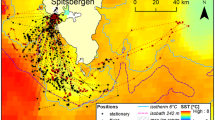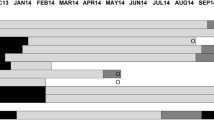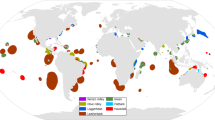Birds taking time off from breeding head for their favourite long-haul destinations.
Abstract
What oceanic seabirds do outside their breeding periods is something of a mystery, although altogether these “sabbaticals’ add up to more than half of their lifetime and are probably a key feature of their life history. Here we use geolocation systems based on light-intensity measurements to show that during these periods wandering albatrosses (Diomedea exulans) leave the foraging grounds that they frequent while breeding for specific, individual oceanic sectors and spend the rest of the year there — each bird probably returns to the same area throughout its life. This discovery of individual home-range preferences outside the breeding season has important implications for the conservation of albatrosses threatened by the development of longline fisheries.
This is a preview of subscription content, access via your institution
Access options
Subscribe to this journal
Receive 51 print issues and online access
$199.00 per year
only $3.90 per issue
Buy this article
- Purchase on Springer Link
- Instant access to full article PDF
Prices may be subject to local taxes which are calculated during checkout


Similar content being viewed by others
References
Weimerskirch, H., Jouventin, P., Mougin, J. L., Stahl, J. C. & Van Beveren, M. Emu 85, 22–23 (1985).
Murphy, R. C. Oceanic Birds of South America (Macmillan, New York, 1936).
Nicholls, D. G., Murray, M. D., Butcher, E. & Moors, P. Emu 97, 240–244 ( 1997).
Jouventin, P. & Weimerskirch, H. Nature 343, 746–748 (1990).
Brothers, N. P. Biol. Conserv. 55, 255–268 (1991).
Wilson, R. P., Ducamp, J. J., Rees, G., Culik, B. M. & Niekamp, K. in Wildlife Telemetry: Remote Monitoring and Tracking of Animals (eds Priede, I. M. & Swift, S. M) 131– 134 (Horward, Chichester, 1992).
Hill, R. D. in Elephant Seals: Population Ecology, Behavior, and Physiology (eds Le Boeuf, B. J. & Laws, R. M.) 227–236 (Univ. California Press, Berkeley, 1994).
Welch, D. W. & Eveson, J. P. Can. J. Fish. Aquat. Sci. 56, 1317–1327 (1999).
Weimerskirch, H., Doncaster, P. & Cuénot-Chaillet, F. Proc. R. Soc. Lond. B 255, 91–97 (1994).
Robertson, G. & Gales, R. Albatross, Biology and Conservation (Beatty, Chipping Norton, Australia, 1993).
Weimerskirch, H., Brothers, N. P. & Jouventin, P. Biol. Conserv. 79, 257– 270 (1997).
Author information
Authors and Affiliations
Rights and permissions
About this article
Cite this article
Weimerskirch, H., Wilson, R. Oceanic respite for wandering albatrosses. Nature 406, 955–956 (2000). https://doi.org/10.1038/35023068
Issue Date:
DOI: https://doi.org/10.1038/35023068
This article is cited by
-
Did the animal move? A cross-wavelet approach to geolocation data reveals year-round whereabouts of a resident seabird
Marine Biology (2021)
-
Individual Chemical Profiles in the Leach’s Storm-Petrel
Journal of Chemical Ecology (2020)
-
Extensive use of the high seas by Vulnerable Fiordland Penguins across non-breeding stages
Journal of Ornithology (2020)
-
Review of dynamic soaring: technical aspects, nonlinear modeling perspectives and future directions
Nonlinear Dynamics (2018)
-
Factors affecting the importance of myctophids in the diet of the world’s seabirds
Marine Biology (2018)
Comments
By submitting a comment you agree to abide by our Terms and Community Guidelines. If you find something abusive or that does not comply with our terms or guidelines please flag it as inappropriate.



